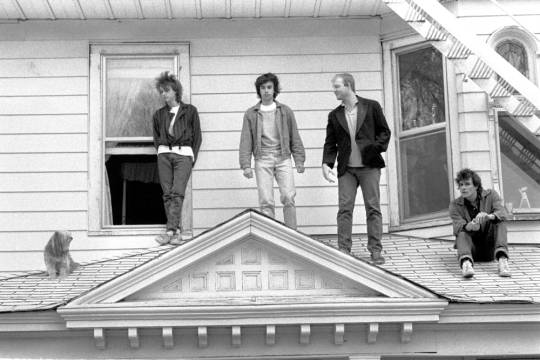-If you are not here for the content- Empty blogs will be blocked. That includes those with only a "self" picture.
Last active 2 hours ago
Don't wanna be here? Send us removal request.
Video
youtube
Left of the Dial (Ed Stasium Mix)
2 notes
·
View notes
Text

"Westerberg’s great gift was to be able to harness that kind of romanticism to noisy, sloppy rock’n’roll (and then to let it show on the quiet acoustic songs – only Neil Young is Westerberg’s match at being able to switch from full-on rock to quiet acoustic and sound utterly himself when doing both) .... "
Ross Palmer, ""Left of the Dial," The Replacements," Songs From So Deep, Wordpress.com. Left of the Dial – The Replacements | songs from so deep
2 notes
·
View notes
Text




Minutemen
The Politics Of Time (1984)
11 notes
·
View notes
Photo


(via Digable Planets – Blowout Comb: Best hip-hop album of the 90s? | Optimistic Underground)
Yea, it is an all-time great. The best compliment: there is not another album that resembles “Blowout Comb.” It is unique.
0 notes
Text

ESPERANZA SPALDING, JAZZ
28 notes
·
View notes
Video
youtube
Amusing.
0 notes
Photo

April is Minnesota Music Month. To celebrate, each weekday this month we’ll be spotlighting a different artist with special coverage on air and online. For Monday, April 13, we’re shining a light on the Replacements.
Known for their deceptively profound songs, notoriously unpredictable live shows, and their lasting influence on alternative rock, the Replacements helped put the Minneapolis punk scene on the map.
The roots of the Replacements extend back to the late ‘70s, when the 19-year-old Bob Stinson handed his 11-year-old brother, Tommy, a bass guitar to keep him out of trouble. The two brothers soon joined forces with the drummer Chris Mars to form the instrumental cover band Dogbreath — and in a twist of fate, their rehearsal was overheard by the songwriter Paul Westerberg, who was walking home from his job as a janitor and would soon be invited over to jam.
Dogbreath eventually morphed into the Impediments and then the Replacements, and made their live debut at the Longhorn Bar in downtown Minneapolis in the summer of 1980. Before long, they had earned a reputation in the local punk scene for their raucous and wildly unpredictable live shows. They became regulars at the newly opened 7th St Entry and signed to the burgeoning label Twin/Tone Records.
Even their earliest recordings capture what was so unique about the band: they were wild and loud, sure, but their songs also had deceptively complex melodies and lyrics. They were inspired by punk rock peers of the era like the Ramones and the New York Dolls, but also by the more songwriter-driven rock of the Rolling Stones, the Faces, and Big Star, whose lead singer Alex Chilton would be forever memorialized in a Replacements song.
The Replacements’ landmark 1984 album Let It Be received rave reviews from critics, with the dean of music criticism himself, Robert Christgau, giving it an A-plus grade. Tommy Stinson, who dropped out of the 10th grade the previous year to hit the road with the Replacements, would joke that it was the only A-plus he received in his life.
The success of Let It Be led to major label offers and a deal with Sire Records, and also led to a chaotic appearance on Saturday Night Live that got the band banned from the set for life. Despite all their success and the obvious quality of their albums and some of their live shows, the Replacements had mastered the art of skating on the razor’s edge of disaster, and their rampant substance abuse and shared impulse to self-destruct would lead to several lineup changes and eventually cause the band to implode.
The true genius of the Replacements’ work is that it has endured for decades beyond the band’s initial life. Though they never became a household name, they are revered by the fans who saw them perform and the countless artists they inspired. You’d be hard-pressed to find a band that gets name-checked more by icons of the alternative rock era; as Paul Westerberg once said, “we were either five years ahead or 10 years behind.”
But as Replacements biographer Bob Mehr noted when he released his book, Trouble Boys, “In 2014, they filled a baseball stadium with 14,000 people singing back their songs to them as generational anthems, which they have absolutely become. In the long run, they won. The victory wasn’t in the moment. It was for all time.”
49 notes
·
View notes
Text
It is how Tim should have sounded. For the most part, I prefer the Stasium remixes, 'Swingin Party' suffers a little, the additional guitar clutters up the song. Nothing really serious in my opinion, but it does not add anything.
The songs that really benefit: back to back - 'Left of the Dial,' and 'Little Mascara.' 'Left of the Dial' has always been a classic, 'Little Mascara' is succinct and breathable in a way it wasn't on the 1985 original.
Other songs that receive a remix boost: 'I'll Buy' and 'Kiss Me On The Bus.' Not the best songs on the album, but offer stronger support in relation to the "classics."
'Hold My Life' - slightly better than the original.
It is amazing what space can do within a song, in some cases, the overall meaning of a particular song is altered because there is more clarity.
youtube
HOW ARE WE NOT ALL TALKING ABOUT THIS!?
45 notes
·
View notes
Text

Westerberg / Hatfield
4 notes
·
View notes
Photo

Talking Heads: Tina Weymouth, Big Star Fanzine #3, 1978
8K notes
·
View notes
Text

Chrissie Hynde and Pete Farndon of the original Pretenders
11 notes
·
View notes




